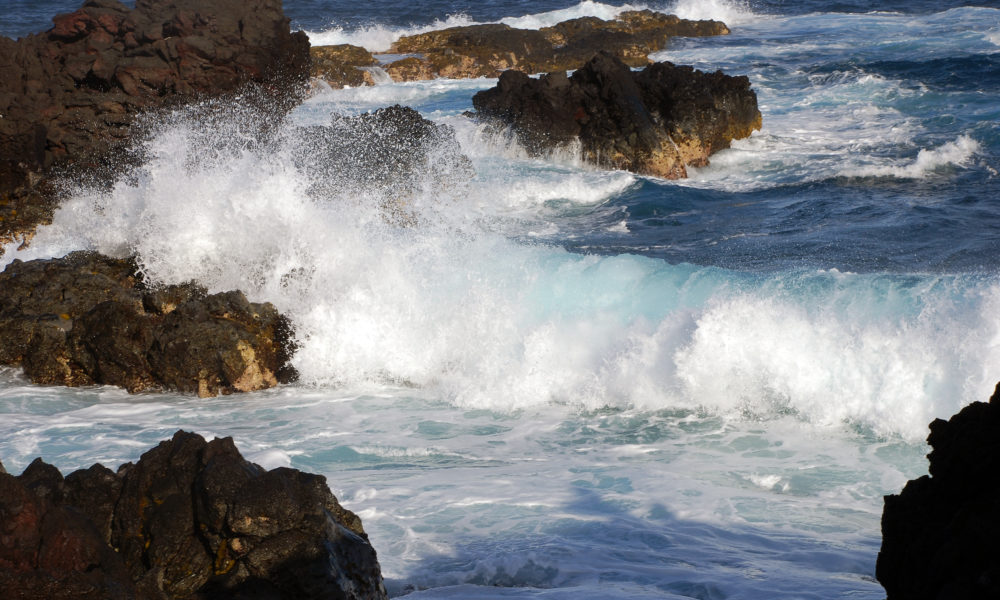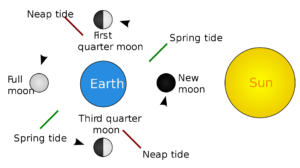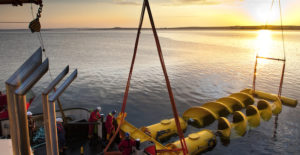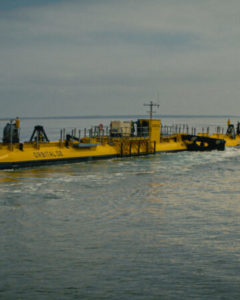
Using the Tides to Meet the Carbon-Free Energy Demand

Tidal schematic (Source: User: KVDP, SVG conversion by Surachit, Public domain, via Wikimedia Commons)
Anyone who has spent a bit of time at the ocean or sea will have noticed how the water levels rise and fall twice a day, independent of the wind or other meteorological conditions. The tides are the result of the gravitational pull of the moon, the rotational force of the Earth, and the sun. The phase of the tide – high or low – and its amplitude (how many centimeters the water rises or falls) depend on the phase of the moon and the placement of the sun. The tide is at its strongest when the Earth, moon, and sun are in alignment, such as at the new moon or the full moon, and at its weakest when the moon is in its first or third quarter.
The most interesting thing about the tides is the energy they contain – enough to power entire communities. And tidal energy is reliable and predictable, and it will continue to be as long as the Earth has the moon.
In its 2020 Innovation Outlook: Ocean Energy Technologies report, the International Renewable Energy Agency says ocean energy can provide affordable, reliable electricity and end-use energy for Small Islands Developing States (SIDS) and boost potable water supplies via seawater desalination. The technology creates jobs, improves people’s livelihoods, and provides other socio-economic benefits. “Ocean energy resources could generate between 45,000 terawatt hours (TWh) and 130,000 TWh of electricity per year,” the report states, noting that tidal barrage technologies dominate the world’s nascent ocean energy output at the moment.
The energy of the tides can be harnessed in many ways. Most solutions right now use turbines that capture this energy as the tides ebb and flow.
One of the world’s largest tidal projects is injecting energy straight into the grid in Scotland using fixed turbines. The four turbines can produce nearly 400 megawatts (MW) of energy for the country (1 MW equals 1 million watts, roughly enough electricity for the demand of 750 homes at once). Turbines like these have no visual impact on the surroundings.
Other companies, such as Orbital Marine Power, are using floating structures to do the same thing. The Scottish company has developed a floating platform generating about 3 gigawatt hours (GWh) of power (1 GW equals 1 billion watts, which could power approximately 876,000 households for one year if they collectively consume 10,000 kilowatt hours each). The company, which specializes in tidal energy technology, is designing a 73-meter floating superstructure with two 1-MW turbines on each side distributed in arrays on the ocean’s surface and positioned in the most energetic parts of the water flow. The device is scalable – “the platform and blade configurations cater for sites and projects of differing characteristics and scale, and turbines can be deployed in arrays much like wind turbines,” it says.
Tidal dams and barrages capture the tidal currents in long concrete structures and run the water through turbines, creating energy that is fed into the grid. And tidal lagoons take advantage of differences in depth to generate the energy to feed into the grid.
The Archimedes screw is a helical corkscrew-shaped device that draws power from the tidal stream as the water moves up through the spiral turning the turbines. They are highly efficient, low cost, and fish-friendly.

Archimedes screw (Source: Tethys Engineering)
A tidal kite works much like a normal kite. Tethered to the sea bed, it carries a turbine below the wing. The kite “flies” in the tidal stream, swooping in a figure-eight shape to increase the speed of the water flowing through the turbine.
The good news is that the options will continue to grow as countries increasingly use the energy of the tides as a means to transition from fossil fuels to sustainable energies:
- In October 2023, the governor of the U.S. state of California signed a bill to encourage the development of wave and tidal energies.
- The U.S. state of New Jersey also has introduced a bill focusing on tidal energy.
- Australia’s 2021 Offshore Electricity Infrastructure Bill has come into force.
- Belgium has revised its offshore renewable energy R&D roadmap.
- Canada has Offshore Renewable Energy Regulations and created an investment tax credit for clean energies.
- According to its 14th Five-Year Plan, China will continue to implement tidal current energy and wave energy demonstration projects, and will explore the application of ocean energy in multi-energy complementary power systems on islands.
- Denmark held the North Sea Summit 2022 to discuss the expansion of renewable energy in the North Sea.
- The European Commission’s Horizon 2020 (its research and innovation funding programme) calls for demonstrations of sustainable tidal energy farms.
- France has an innovative “experimentation contract” for renewable energies, especially for ocean energies and floating offshore wind energy.
- India’s Deep Ocean Mission, launched in 2021, implemented by the Ministry of Earth Sciences, is supporting the government’s Blue Economy Initiatives.
- Korea has a 2030 Ocean Energy Development Plan.
The list in the International Energy Agency–Ocean Energy Systems Annual Report 2022 has many of these examples and more. The report also notes, however, that the technologies require additional policy support for energy research, development, and demonstration.


